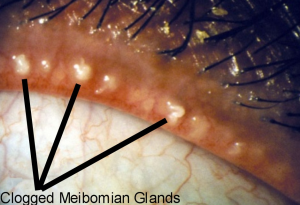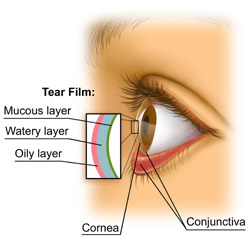Dr Staton and I spent attended the UC Berkeley School of Optometry lecture and workshop on “Dry Eye Disease: the Latest Trends in Clinical Care and Scientific Research.” Many eye conditions cause feelings of dryness,  discomfort, burning, foreign body sensation or blurred vision. “Dry Eye” is a general term that is more a symptom of ocular surface disease than a cause. Many people stop wearing contact lenses because of poor tear quality. The majority of dry eye disease is caused from obstruction of the meibomian glands. The meibomian glands are located in the eyelids and secrete meibum, a substance important to the tear quality and health of the front surface of the eye. The accurate diagnosis and management of dry eye requires special evaluation that extends beyond a standard eye exam.
discomfort, burning, foreign body sensation or blurred vision. “Dry Eye” is a general term that is more a symptom of ocular surface disease than a cause. Many people stop wearing contact lenses because of poor tear quality. The majority of dry eye disease is caused from obstruction of the meibomian glands. The meibomian glands are located in the eyelids and secrete meibum, a substance important to the tear quality and health of the front surface of the eye. The accurate diagnosis and management of dry eye requires special evaluation that extends beyond a standard eye exam.
We have been experimenting and testing different eye drops, eyelid cleaning solutions and heat compresses to find the most cost effective and best results. Some dry eye treatments require prescription eye drops, oral medications, and/or punctual occlusion.
Dry eye can cause significant discomfort and poor vision for the person suffering from it. We are planning to aggressively treat and control dry eye causes and symptoms. Don’t be surprised if either one of us asks you to schedule a dry eye assessment. Or you can be proactive and schedule yourself.
We are starting the dry eye clinic on Thursdays and will expand as demand requires.
Tag: gritty eyes
Dry Eye Symptoms and Treatments
Last time I talked about the risks of dry eye. This included the increase incidence for people with diabetes. Today let’s talk about the symptoms. Dry eye presents in many different ways: the eyes can sting, burn, feel gritty, scratchy and even watery. That’s right, you can suffer from dry eyes and produce too many tears. The other significant symptom of dry eyes is fluctuating vision. If the tears evaporate too quickly, vision is best right after a good blink and blurs until the next blink. Identifying which layer or layers are compromised is the first step to finding the right treatment.
The tears consist of 3 different components:
1. Oils or lipids from the meibomian glands (in the eyelid)
2. Mucus from the goblet cells (surface of the eye)
3. Water or aqueous from the lacrimal gland (under the brow)
The eyelid can be a problem too. Inflammation of the eyelid margin is often a factor. The eyelid changes with age, it may be scarred or looser causing the lid to turn inward or outward. Either direction has a negative effect on the tears and blinking.
The goal of dry eye treatment is to restore the tear film balance. Addition of a humidifer, drops, ointments, supplements, change in diet, and/or punctal plugs can all be helpful. Once the cause of dry eye disease is identified I can create a treatment plan.
The first thing I recommend in treating dry eye disease is to control the factors that you can. Check out the last blog for a list, you can’t change your age or gender, but you can control your blood sugar, and some environmental factors. What you eat or do not eat matters too. Too much caffeine will dehydrate you. If you are a fan of energy drinks that are high in caffeine and sugar, try a week or two without them and see if your eyes feel better. I’ve seen significant improved in contact lens tolerance with the elimination of these drinks.
Do not suffer from dry eye, call Westside Optometry for evaluation and treatment. For more dry eye information download http://old.westsideoptometrynow.com/wp-content/uploads/2010/05/Dry-Eye-Syndrome.pdf
